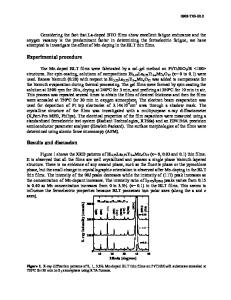Effect of Thermal Strain on Domain Fraction in a-/b-axis-oriented Epitaxial Bi 4 Ti 3 O 12 Films
- PDF / 172,136 Bytes
- 6 Pages / 612 x 792 pts (letter) Page_size
- 83 Downloads / 287 Views
C4.2.1
Effect of Thermal Strain on Domain Fraction in a-/b-axis-oriented Epitaxial Bi4Ti3O12 Films Takayuki Watanabe1, Hitoshi Morioka1, Shoji Okamoto1, Masatake Takahashi2, Yuji Noguchi2, Masaru Miyayama2, and Hiroshi Funakubo1,3 1 Department of Innovative and Engineered Materials, Tokyo Institute of Technology, 4259 Nagatsuta, Midori-ku, Yokohama 226-8502, Japan 2 Institute of Industrial Science, University of Tokyo, 4-6-1 Komaba, Meguro-ku, Tokyo153-8505, Japan 3 PRESTO, JST, 4-1-8 Honcho, Kawaguchi, Saitama 332-0012, Japan ABSTRACT a-/b-axis-oriented epitaxial Bi4Ti3O12 and neodymium-substituted Bi4Ti3O12 films with a different a-domain fraction, V(100)/[V(100)+V(010)], were grown by metalorganic chemical vapor deposition above the phase transition temperature. It was demonstrated that the saturation polarization observed for the a-/b-axis-oriented film is proportional to the a-domain fraction estimated by x-ray diffraction. The liner relationship passing through the origin revealed that the 90° domain switching by an external electric field hardly occurred. The extrapolation gave spontaneous polarization of 58 µC/cm2 for a pure a-axis-oriented (Bi3.5Nd0.5)Ti3O12 film. The domain fraction was investigated as a function of thermal strain originated from a difference in thermal expansion coefficient between the film and substrates. The domain fraction of the films changed with the thermal strain along the in-plane [010] in tetragonal a-axis-oriented films as well as epitaxially grown tetragonal Pb(Zr,Ti)O3 films.
INTRODUCTION Bismuth layer-structured ferroelectrics (BLSFs) have been investigated for ferroelectric random access memory (FeRAM) application due to the lead-free composition and high fatigue resistance. Interestingly, these materials with natural superlattice structure of stacking of (Bi2O2)2+ layer and pseudoperovskite layer have tunability in ferroelectric properties by substituting lanthanoide and/or high valent cation for the perovskite A- and B-sites, respectively. To date, improvements in fatigue endurance, enhancement of switching charge, and design of coercive filed by using the substitution techniques were reported especially for SrBi2Ta2O9 and Bi4Ti3O12 (BIT) [1,2]. Sr(Bi,Ln)2Ta2O9 and (Bi,Ln)4(Ti,V)3O12: Ln is lanthanoide, are promising candidates for ferroelectric random access memory. For obtaining large switching charge that is essential for high-density memory, not only the substitution technique but also an orientation control technique is needed. The major spontaneous polarization vector is parallel to only the a-axis. Hence, the large anisotropy allows the largest switching charge for an a-axis-oriented film. Additionally, there is almost no report for remarkable 90° domain switching for deposited thin films. In general, thermal poling and pulsed treatment are performed for bulk ceramics as an approach to a homogeneous polarization state. However, such processes are not desirable for highly integrated devices. Films with homogeneous crystal orientation that can provide large enough s
Data Loading...











